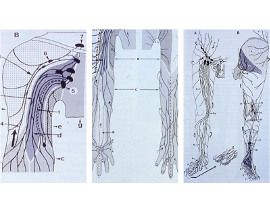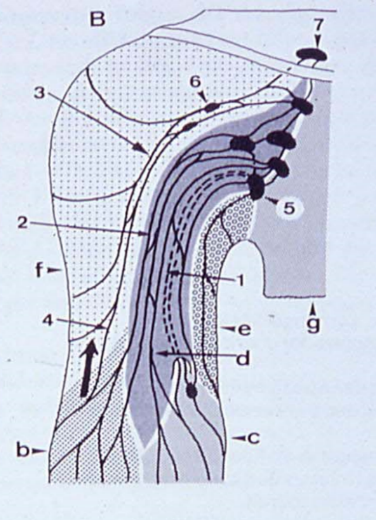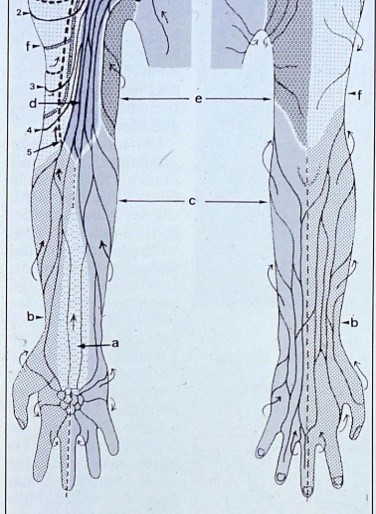- 905.829.0724
- info@yourhealthwellnesscentre.com

The following information and images are part of the presentation slides for the treatment of lymphedema course offered by the Academy of Lymphatic Studies and are reproduced here with the permission of the Academy.
For information on the stages of lymphedema, see Lymphedema, part 2.
Lymphedema occurs if the lymphatic system becomes insufficient and is unable to perform its normal functions. The result is an abnormal accumulation of water and proteins principally in the subcutaneous tissues.
Lymphedema is most commonly present in the extremities, it may also affect the trunk, abdomen, head and neck, the external genitalia as well as in inner organs; its onset is gradual in some patients and sudden in others. Most patients in the Western Hemisphere develop lymphedema after surgery and/or radiation therapy for various cancers (breast, uterus, prostate, bladder, lymphoma, melanoma), in which case it is referred to as secondary lymphedema. Other patients develop it without obvious cause at different stages in life (primary lymphedema), and still others develop it after trauma or deep vein thrombosis. In third world countries, parasites (filariasis) account for millions of cases.
Lymphedema is serious due to its long-term physical and psychosocial consequences for patients; it continues to progress if left untreated.



The lymph coming from the upper extremity drains for the most part into the axillary lymph nodes, as shown beside on first diagram. Part of the lateral upper arm may also drain into supraclavicular lymph nodes. In case of breast cancer with dissection, or radiation (or a combination of both) of lymph nodes, the drainage of lymph from the upper extremity will be impaired. This could cause an accumulation of lymph, in this case protein and water in the arm, resulting in secondary lymphedema.
The lymph coming from the lower extremities drains into the inguinal lymph nodes, as shown beside on diagram. Dissection and/or radiation of these lymph nodes could result in secondary lymphedema. The more common reason for the onset of lymphedema in the lower extremity are congenital (malformations of the lymphatic system), resulting in primary lymphedema.
Dynamic insufficiency is often caused by insufficient venous return, which can be caused by Congestive Heart Failure, Venous Insufficiency, sitting or standing too long, pregnancy, and other pathologies. Manual Lymph Drainage and Complete Decongestive Therapy is not indicated in case of dynamic insufficiency. The appropriate therapeutic approach would be ambulation, elevation, exercises and – if indicated – a compression garment. If dynamic insufficiency is left untreated over an extended period of time, secondary damage to the lymphatic system may occur due to strain on the lymph collectors. Lymph collectors work on their maximum capacity in dynamic insufficiency. This can cause a mechanical insufficiency (damaged lymphatic system) in which the transport capacity reduces to such an extent that it can no longer cope with the normal amount of lymphatic load. Mechanical insufficiency can be caused by: Surgery, Radiation, Infections, Trauma and Congenital malformation. Mechanical insufficiency causes lymphedema (high-protein swelling in the interstitial tissues). In case of a mechanical insufficiency, the lymphatic system is unable to remove the protein and water molecules from the tissues, resulting in an accumulation of these substances.
Lymphedema can be classified as either primary or secondary, based on underlying etiology. However, this classification has little significance in determining the method of treatment. Both are treated with decongestive therapy. Primary Lymphedema is caused by congenital malformations of the lymphatic system and can be present at birth or develop some time during the course of life. The most common malformation of the lymphatic system is known as “Hypoplasia”. In hypoplasia, the number of lymph collectors is reduced and the diameter of existing lymph vessels is smaller than normal. This results in a decrease in the transport capacity. If transport capacity is reduced to such a level that normal amounts of lymphatic loads can’t be drained anymore, lymphedema develops → primary lymphedema. Primary lymphedema generally affects the lower extremity. The mechanical insufficiency present in secondary lymphedema is caused by a known insult to the lymphatic system. Most common causes for secondary lymphedema include surgery and radiation, trauma, infection, malignant tumors, and others.
Surgery and radiation is by far the most common cause for secondary lymphedema. Surgical procedures in cancer therapy commonly include the removal (dissection) of lymph nodes. The goal of these procedures is to eliminate the cancer cells and to save the patients life. A side effect in lymph node dissection and radiation is the disruption in the lymph transport. If the remaining lymphatics are unable to manage the lymphatic load, secondary lymphedema will develop.
Traumatic insults involving the lymphatic system may cause a significant reduction in lymph flow, resulting in secondary lymphedema (burns, larger skin abrasions). Scar tissue hinders regeneration of lymph collectors, further exacerbating the problem. Post-traumatic secondary lymphedema develops from a mechanical insufficiency of the lymphatic system as a result of tissue lesions and should not be confused with post-traumatic edema. Post-traumatic edema is a local result due to trauma, which usually recedes after a few days.
Recurrent acute or chronic inflammatory processes affecting the lymphatic system may result in mechanical insufficiency. The most common cause for inflammation of the lymphatic system and lymphedema in general is filariasis. Lymphatic filariasis is endemic in more than 80 countries in the tropics and subtropics and is caused by thread-like, parasitic filarial worms (Wuchereria bancrofti) that live almost exclusively in humans. Lymphatic filariasis is transmitted when an infected mosquito bites a person, then goes on to bite others, thus infecting them with the parasites. The worms live for 4-6 years lodged in the lymphatic system, where they reproduce. The toxicity of the waste products produced by these worms results in inflammation and obliteration of the lymphatic system, leading to often extreme swelling of the lower extremities and genitalia.
Malignant tumors may mechanically block the lymph flow by pressing against lymphatic structures from the outside. Malignant cells may also infiltrate the lymphatic system and proliferate in either lymph vessels or lymph nodes, thus blocking the flow of lymph.